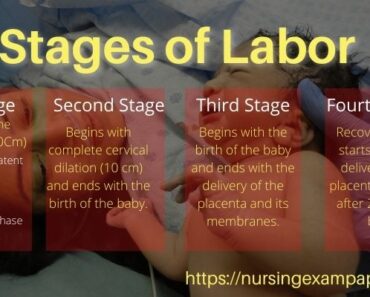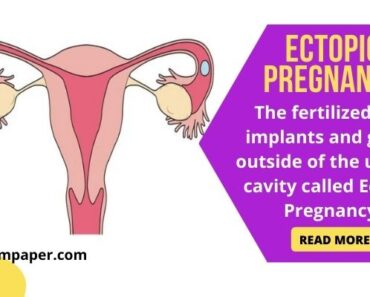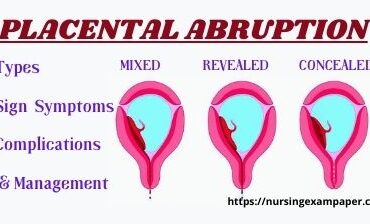Normal labor definition: – Labor is a normal process, in which the fetus and placenta are expelled outside the world through the vagina, from the uterus by a series of continuous progressive contractions of the uterus (that whole process is described in stages of labor). Uterine contractions, help in the cervix dilation and effacement. Labor mainly starts two weeks before and two weeks after EDD (Estimated Date of Delivery).
Labor is defined as normal eutocia labor and abnormal / dystocia labor.
Normal Labour / Eutocia
- Spontaneous onset
- Low risk throughout labor and delivery.
- The baby is born spontaneously in vertex position between 37 to 41 weeks of gestation.
- Both mother and baby are in good condition after birth.
Dystocia / Abnormal Labour
- Abnormal labor involves a condition that is
- Mal presentations
- Mal positions
- Abnormal maternal pelvis and other conditions that affect maternal and fetal outcomes.
Signs and symptoms of labor
The signs for labor vary from woman to woman, symptoms occur a few days before delivery, some of the common symptoms are given below:
Contractions-
Pain starts in the Lower Abdomen and lowers back due to uterine contractions (muscles of the uterus get tight and relax). Women are in true labor when they have strong and regular contractions, and the contractions get stronger and closer over time.
Bloody or brownish discharge
Women have bloody mucus discharge called bloody show.
Water breaks
In the womb, the baby lives in a sac made of membranes filled with water called amniotic fluid. When labor is about to take place, the pressure exerted by the contractions of the uterus causes the membrane to rupture, and when the membrane ruptures, the amniotic fluid comes out and that process is called a water break.
Normal Delivery Pain
Sometimes false symptoms appear during labor, so how do identify true labor and false labor, here are some differences between the symptoms to identify true labor.
| True labor | False labor |
|---|---|
| Pain occurs at regular intervals. | Pain occurs at irregular intervals. |
| The interval between contractions gradually shortens. | The interval between contractions may larger. |
| Increase in frequency intensity and duration of contraction. | No increase. |
| Pain in both back and front. | Mainly in the front lower abdomen. |
| Bloody show present. | No show. |
| The interval between contractions may be larger. | No change in the cervix. |
| Cervical dilation increases with contraction. | Relief. |
Stages of labor
There are four Stages of labor
- First Stage:- Dilation of the cervix
- Second Stage:- Delivery of the baby.
- Third Stage:- After birth Delivery of the placenta.
- Fourth Stage:- Recovery.

First Stage of labor – Dilation of the cervix
The first stage of labor starts from the time the construction starts and the First Stage completes when the cervix is fully dilated approximately 10cm. The first stage of labor is divided into three phases.
A. Early phase, B. Active phase, C. Transitional phase.
Early phase / Latent Phase
The early phase / Latent phase is the longest phase its duration can be 20 hours mainly in primi mothers, and women may feel mild contractions that come every 5 to 15 minutes and last 50 to 90 seconds. Women may have reddish or bloody vaginal show and also water.
Active Phase
- The active phase begins when contractions become stronger and the active phase has a regular duration of 4 to 8 hours.
- The cervix dilates to 6 cm in the active phase.
- Contractions become stronger and more painful and may come after every 3 to 5 minutes.
- Feel the pressure in the lower back and there may be cramps in the legs.
Transitional phase
It’s the final phase of the First Stage. In this phase, cervix Dilation progresses from 7 to 10 cm in less than an hour. Contraction comes closer together and in the last 60 to 90-second women feel like want to beer down.
The Second Stage of Labor – Till the birth of the baby
- The second stage of labor begins with complete cervical dilation (10 cm) and ends with the birth of the baby.
- The duration of the second stage is 30 minutes to 3 hours in primigravida and 5 to 25 minutes in multigravida.
- The second stage may be longer when women have an epidural, an epidural is the most common type of pain relief during labor. This can cause contractions to slow down.
- Baby’s head begins to show curled Crowning, then Health workers provide help to you in the delivery of your baby.
The Third Stage of Labor – Till the delivery of the placenta and its membranes.
The third stage of labor begins with the birth of the baby and ends with the delivery of the placenta and its membranes.
The duration of the third stage is 15 to 20 minutes but can be as long as 5 to 10 minutes.
After the delivery of the placenta, the uterus will shrink back to its normal size
Healthcare providers should massage the abdomen and this may help with uterine contractions.
4th Stage of labor
The fourth stage of labor starts after the delivery of the placenta and lasts after 2 hours of birth.
Abdominal massage and breastfeeding help the uterus contract to its normal size. An injection of Oxytocin at 10 units given IM also improves the contraction of the uterus.
4th Stage is a very important stage in stages of labor for preventing PPH Postpartum hemorrhage so Health Care providers should
- Check vitals every 15 minutes
- Check the size of the uterus
- Check for any bleeding heavy to prevent PPH
- Encourage women to breastfeed because breastfeeding improves Oxytocin release
Ref- NCBI
Stages of Labor, Stages of Labor, Stages of Labor, Stages of Labor, Stages of Labor, Stages of Labor, Stages of Labor, Stages of Labor, Stages of Labor, Stages of Labor, Stages of Labor, Stages of Labor









Clinical Nursing